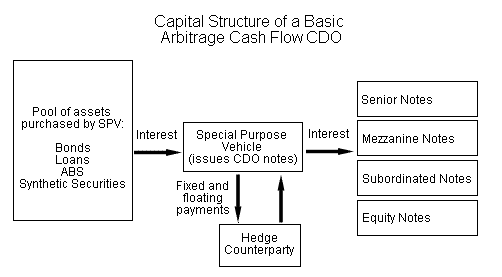

Collateralized Debt Obligation (CDO)
Overview:
A Collateralized Debt Obligation (CDO) is an investment vechicle that is similar to a regular mutual fund that buys bonds. The major difference is that a CDO is funded by issuing bonds itself instead of a issuing shares like a mutual fund. There are many kinds of CDOs and ones that invest in bonds alone are known as collateralized bond obligations (CBO). Others can invest in loans (collateralized loan obligations, CLO), asset-backed securities such as mortages (structured finance collateralized debt obligations, SF CDO), and synthetic securities (collateralized synthetic obligation, CSO).
Reason for CDOs:
The entire CDO market was created in the 1980s to help banks with regulatory capital relief. A bank's primary source of income is derived from issuing loans to corporations and individuals. After the loan is issued, the bank is required by law to keep a certain percentage of the loan (usually 8%) in cash. By selling the loan to an investor, the bank can free up this capital and focus on issuing more loans.
By selling many loans together at one time, a bank is able to free a large amount of capital very efficently. This is done by creating a new company, called a special purpose vehicle (SPV), which will purchase the loans. The SPV raises the funds to purchase these loans by issusing several bonds of its own to many investors. In the end, banks are able to free up billions of capital and investors have additional investment opportunities with favorable characteristics. CDOs issued for this purpose are known as balance sheet CDOs.
The other kind of CDO currently in the market is called an arbitrage CDO, which is created mainly by asset management firms. These only started becoming popular in the late 1990s and now are the majority of CDOs issued. These firms earn fees bases on the amount of assets they manage and CDOs can add a significant amount of revenue to the firm. The goal for this kind of CDO is to earn more interest on the underlying collateral (the securities the SPV purchases) than it will owe to its liabilities (the bonds the SPV has issued).
Structure:
CDOs are highly structured investment vehicles that have many covenant tests and requirements. These requirements help lower the chance of massive amounts of defaults occuring and can vary widely among CDOs. Some examples of these tests are:
- Minimum average fixed coupon (average coupon for all assets)
- Minimum average rating (from a specific rating agency such as Moody's, S&P, or Fitch)
- Largest single issuer
- Weighted average life
- Minimum diversity (Moody's has created their own calculation which is the market standard)
The figure below details the capital structure of a CDO:
